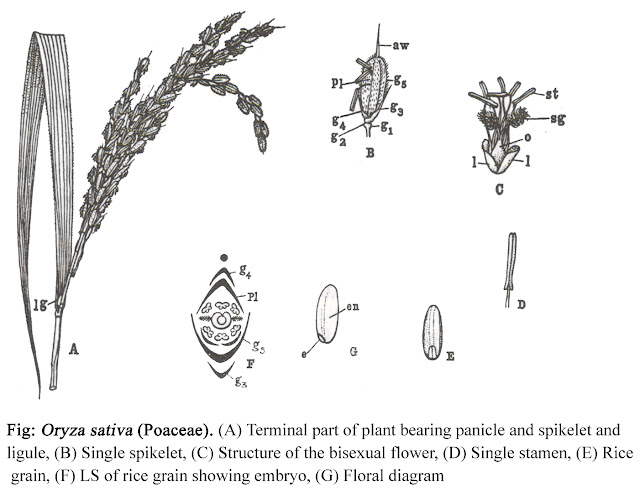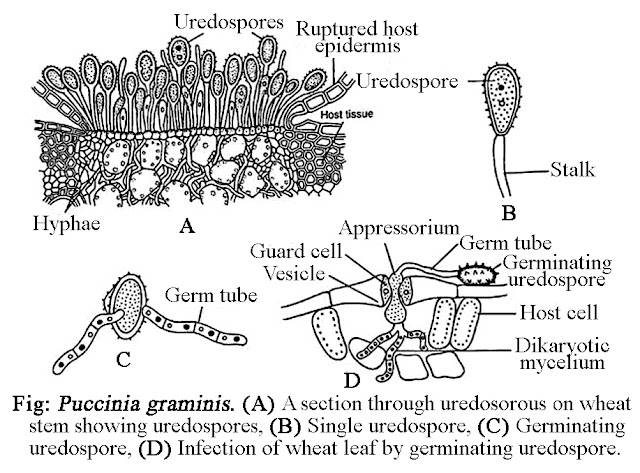POACEAE
1. SYSTEMATIC POSITION:
Bentham
& Hooker
Division: Phanerogames (Seed Plants)
Class:
Monocotyledones
Series:
Glumaceae
Family: Poaceae
2. MORPHOLOGICAL
CHARACTERS:
Habit
– Usually annual or perennial herbs.
Stem
– Clums erect, ascending, creeping, terete, internode hollow, nodes
swollen, creeping rhizome or stolon present.
Leaves
– Simple, alternate, often crowded at the base, consisting of sheath, blade
and ligule, blade usually long, narrow and entire.
Inflorescence
– Spikelets, these are very small spikes with one or more flowers arranged
in spike, raceme or panicle, flowers stalked or sessile. Each spikelet bears at
its base two minute scales or bracts called empty glumes. Slightly above, it
bears a third bract called flowering glume or lemna. Opposite to the lemna/
flowering glume a small 2-nerved bracteole called palea is present.
Flower
– Florets small, inconspicuous, bisexual or unisexual, zygomorphic,
hypogynous.
Perianth
– 2 or rarely 3 or 0, represented by minute membranous scales called
lodicules.
Androecium
– Generally 3, sometimes 6 or reduced to 2 or 1, filaments long, anther
versatile, dithecous, basifixed introrse, dehisce by a longitudinal slit.
Gynoecium
– Bi or tricarpellary, syncarpous, ovary superior, unilocular with ovuls,
placentation axile, styles 1-3, commonly 2, short, stigma usually 2, feathery,
arise from the carpellary wall. In Zea
mays, the style is long and silky, placentation basal.
Fruit
– Caryopsis.
4.
COMPARATIVE
SYSTEMATIC POSITION AND AFFINITIES:
Bentham &
Hooker have placed the family Poaceae along with the Cyperaceae in the series
Glumaceae. Engler & Prantl placed both the families in their order
Glumiflorae, while Cronquist placed them in his order Cyperales. Hutchinson and
Takhtajan placed the family in an order of its own which they named as
Graminales (for Cyperaceae) and Poales (for Poaceae) respectively.
The
Poaceae are one of the most successful families of the flowering plants with
reduced flowers adapted for wind pollination. They are considered to be very
advanced group of angiosperms and evolved from primitive liliaceous ancestral
stocks.
Superficially,
Poaceae is considered to be resembled with Cyperaceae. In both these families,
the flowers are small, inconspicuous, subtended by bracts and present in the
form of spikelets. However, Poaceae differs from Cyperaceae by their usually
terete, hollow, joined stems, structure of spikelet, etc.
Hutchinson
suggested that the grasses developed parallel with the Sedges from liliaceous
stocks through the Juncaceae complex.
5.
ECONOMIC
IMPORTANCE:
The family is economically important in various
respects like food value, fodder, making sugar, medicinal, aromatic and
manufacture of paper, mats baskets, etc.
1. The important cereal plants are – Triticum aestivum, T. sativum, T. vulgare, Zea mays, Oryza sativa,
Avena sativa, Hordeum vulgare, Sorghum vulgare, Andropogon sorghum, Panicum
miliaceum, Pennisetum typhoides, etc.
2.
The fodder plants of the family include – Cynodon
dactylon, Bothriochloa pertusus, Panicum maximum, Paspalum spp., Desmostachya
bipinnata, etc. The dried stems and leaves of those plants are used as
fodder for cattle.
3. Saccharum officinarum (sugar cane) is used in the manufacture of
sugar.
4. Stems of various species of Bambusa e.g., B. tulda, B. vulgaris, B. polymorpha, Melocanna bambusoides,
Dendro-calamus spp., etc are used for building materials and in paper
industry. Split stems are used to manufacture raw mats, baskets, tool-handles,
etc.
5. Some plants of the family are
aromatic and used as perfumes and oils. Roots of Vetiveria zizanioides yields vetiver
oil. Other scented oil yielding plants are the species of Cymbopogon e.g., C. mar-tini,
C. nardus, C. citratus, etc.
6. Medicinal grasses include – Phragmites karka, Secale cereal, etc.
*************





Comments
Post a Comment